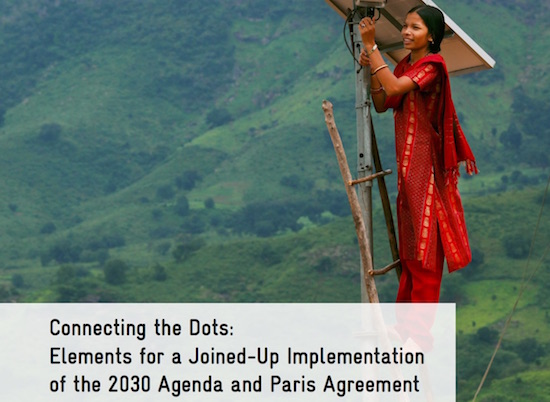Primary Functions
- Support governments as they embark on an integrated approach to the SDGs and Paris climate goals by drawing on early experience and case studies from first mover countries.
Detailed Description
National-level implementation of the 2030 Agenda for Sustainable Development and the Paris Agreement on climate change generally proceed on different tracks, despite growing recognition of the ample opportunities they present for synergies.
In most countries, climate actions under the Nationally Determined Contributions (NDCs) and national targets underpinning the global Sustainable Development Goals (SDGs) have been defined and advanced separately. This siloed approach makes little sense given the short window of opportunity for tackling the interlinked challenges of climate change, ecosystem degradation, inequality rise, and political instability.
Drawing on experience in 11 countries and the European Union, this paper provides core elements and concrete examples for jointly advancing these agendas, with a focus on five challenges: coordinating institutions, aligning national climate and SDG-relevant targets, mainstreaming both set of goals into policy planning, optimizing financial resources, and building mutually reinforcing monitoring and reporting frameworks. The research also explores how international development can better support national efforts at linking both agendas.
This study shows that joining up implementation requires governments to make significant shifts in institutional, policy, financial, and monitoring frameworks in order to enhance policy coherence, and cost efficiency.
In most countries, national coordination frameworks for the SDGs and climate action are led by distinct institutions and engage stakeholders through different arrangements. Based on a survey of 90 countries conducted by WRI, this paper highlights that, on average, seven out of eight countries chose environment ministries to steer NDC implementation while they entrusted the 2030 Agenda to more central cabinet-level institutions, such as offices of the president or prime minister or planning and finance ministries. Policymakers from across survey countries report significant challenges in connecting the two processes because each has its own history, community of actors, and political dynamics. As a result, national SDG-relevant targets and climate actions are often defined with limited coordination between relevant agencies. Efforts at embedding the two sets of goals in development plans also lack an integrated approach, and the proliferation of different guidance for SDG, NDC, gender equality, and green growth mainstreaming overload planning processes.
Given the short time frame for meeting the ambitious SDGs and Paris goals, it is imperative that countries shift to a more joined-up approach to implementation. This paper seeks to support governments as they embark on this process by drawing on early experience by first mover countries.





